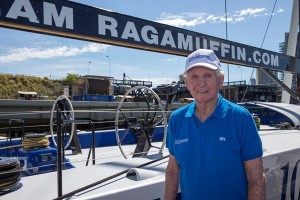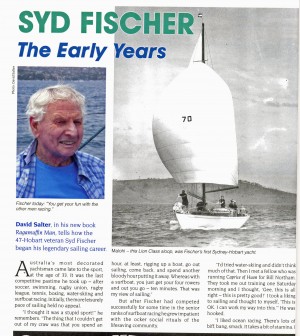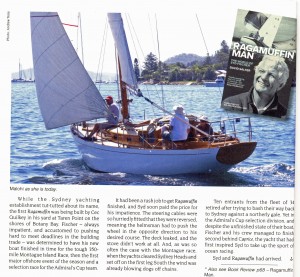| Syd Fisher | |
|---|---|
 | |
| Gender | Male |
| Date Born | 1927 |
| Status | Deceased |
| Date of Death | 2023 |
| Nationality | Australian |
| Hometown | Sydney |
| Club | Cruising Yacht Club of Australia Middle Harbour Yacht Club |
| Boat Owner of | Malhohi Penando Ragamuffin Salacia |
Syd Fisher
Stories | Vale Syd Fisher by Di PearsonExcerpts from article: Vale Syd Fischer AM OBE - Cruising Yacht Club of Australia (cyca.com.au) Yachting legend Syd Fischer passed away on Thursday 23 February 2023. He was 95. Born 4 March, 1927, Fischer stood head and shoulders above the rest. His work life revolved around the building industry, property development and the marine industry, including Sydney City Marine, these days managed by grandson Brenton Fischer. Article mentions his:
Syd Fisher the Early YearsArticle in the Afloat Magazine December 2016 Australia's most decorated yachtsman came late to the sport, at the age of 33. It was the last competitive pastime he took up - after soccer, swimming, rugby union, rugby league, tennis, boxing, water-skiing and surfboat racing. Initially, the more leisurely pace of sailing held no appeal. "I thought it was a stupid sport!" he remembers. "The thing that I couldn't get out of my craw was that you spend an hour, at least, rigging up a boat, go out sailing, come back, and spend another bloody hour putting it away. Whereas with a surfboat, you just get your four rowers and out you go - ten minutes. That was my view of sailing." But after Fischer had competed successfully for some time in the senior ranks of surfboat racing he grew impatient with the ocker social rituals of the lifesaving community. "I'd tried water-skiing and didn't think much of that. Then I met a fellow who was running Caprice of Huon for Bill Northam. They took me out training one Saturday morning and I thought, 'Gee, this is all right - this is pretty good!' I took a liking to sailing and thought to myself, 'This is OK. I can work my way into this.- He was hooked. I like ocean racing, there is a lot of biff, bang and smack. It takes a lot of stamina the blokes in ocean racing are pretty hardy kinds. I found in ocean racing the kind of blokes I was used to in football and surf clubs - the types who had a go, and liked a bit of fun. I don't think that I was anything out of the box. If you enjoyed team sports, that was it. "You get your fun with the other men racing." With typical impatience, Syd leap-frogged the traditional years spent as a crew-member slowly learning the complexities of yacht racing from the older hands. "No, I skipped that. I don't think it makes much difference to be honest." Instead, he plunged straight in and bought himself a 41-foot yacht. He would be skipper or nothing. "I bought a boat that was on a mooring at the Cruising Yacht Club called Carefree. We re-named it Penando after my three daughters - Penny, Annabel and Dominique. It was a hulk. Been there for years and the anchor chain had rotted through the deck. "But being a carpenter I just put it up in Careening Cove, put a new deck on it, caulked it, painted it - looked beautiful! Took it out one day with a bloke called Dick Taylor. It was a bit of a black Nor'easter. We went over a few waves, and Dick looked over the side and said, 'You're not going to be happy'. The caulking wasn't good." By then Fischer knew enough about boats to realise that if a yacht's planking wouldn't hold tight then it was probably time to sell. Nevertheless, he sailed Penando for a few seasons, learning some hard lessons in the early years. "The first race I had was in about 65 knots of wind on the Harbour and I ended up sticking the boat up on Cremorne Point. We jumped out of the boat and got it off the bloody bricks and got it back to Middle Harbour. That was some experience. "I remember we raced Penando at Middle Harbour one day when Horrie Godden was club commodore. It was a real wild breeze and we were going down towards Manly. I put a kite up and no one else did. We bloody near went up The Corso because we had a lot of trouble getting the thing down. I remember Horrie coming up to me afterwards and saying, 'You know, Syd, you don't have to put a kite up in that weight of breeze!' "There's lots of things that you did in the early days that were a bit stupid, but they're the things you do. The first ocean race I went on with the boat we got about five miles offshore and the tiller broke. So I turned around and brought it back with a pair of wrenches on the rudder shaft. It wasn't a good boat." It was time to trade up. Syd sold Penando and bought the 36-foot Malohi in time for the 1962 Sydney-Hobart race. She was a sturdy Lion-class sloop, sister-ship to Siandra, which had previously twice won the race on handicap with Graham Newland at the helm. Fischer had now caught the Sydney-Hobart bug, and already understood that the key to winning that 628-mile race was combining an experienced crew with a boat that rated well under the prevailing handicap system. At his first attempt as skipper in the Hobart race Syd sailed Malohi into 5th place - a creditable result. In 1963 he came a disappointing 17th, but in 1966 Malohi roared back to score another 5th place finish. Fischer's early Sydney-Hobart campaigns also saw the foundation of a sailing partnership that would last for the next 45 years. Tony Ellis-'Ace' or 'Grumpy' to his mates - was a gifted young skiff sailor who'd been recruited to the offshore ranks. As is often the case with Syd, their friendship had its origins in conflict. Ellis remembers the moment with a smile. "I was coming home from Hobart on Salacia in 1962 or '63. We were up at Triabunna for the Crayfish Derby. Syd in those days was a fairly fit young guy in his mid-30s. They had a bit of a function on and he's got one of the birds out on the dance floor there," Ellis said. "1 thought, 'I'll make a bit of a nuisance of myself here' and tried to cut in. Syd said, "'Listen you young c--t. F--k off or I'll bloody well deck you!' He was still pretty good at boxing back then - and he was a lot bloody bigger than me! That's how we started." With his competitive instincts now properly roused, Fischer sold Malohi but retains a soft spot for the boat, which now races as a 'classic' and is still moored in sight of his boatshed home on Mosman Bay. He was looking for bigger offshore challenges, but wasn't quite sure what form they would take. Syd recalls how other, more experienced ocean racing campaigners then seized the opportunity. "Graham Newland and Doug Paterson came to me then and said, 'You're a competitive person. Why don't we put together a boat for the next Admiral's Cup?' I said, 'What's the Admiral's Cup?' I didn't have a clue." Fischer's first of eight Admiral's Cup campaigns had ambitious beginnings. The winter of 1967 was spent putting a new boat and crew together. The design was from the fabled Sparkman & Stephens office in New York. Olin Stephens had drawn the lines of Intrepid, the breakthrough 12-metre that had just defended the America's Cup in a thumping 4-1 whitewash of the Australia challenger, Dame Pattie. Syd's strategy was to surprise his opponents with a much larger, more powerful ocean racer than was then the norm. "She was 49 foot and 65/8 inches long. Quite a big boat in those days. It was the biggest boat in the fleet in Cowes, which meant that, all things being equal, you get out front and don't eat too much bad gas. That was the start of the Ragamuffins." And how did that famous Ragamuffin name come about? According to Fischer, who by then was already a successful builder and developer, he'd lent the ladies auxiliary of the NSW Benevolent Society a penthouse in one of his new apartment blocks for a fundraising function. They called themselves the Ragamuffin Committee and Syd remembers that some of those women were "pretty spirited, and certainly a bit cheeky". The word "ragamuffin"- an urchin, or person in ragged, dirty clothes - must have stuck in Fischer's mind. Not long after, he was steering Malohi in an offshore race and thinking about what to call the new boat he was having built. "Hey, what about Ragamuffin?" he called out to his crew above the sound of the waves. "Initially they said nothing," he remembers, "but half an hour later the crew came back and said 'yes'. I just thought it would be a nice name because it was cheeky - and a bit naughty." Syd and his crew certainly liked the name but the flag officers of the Cruising Yacht Club, under whose burgee the Admiral's Cup team would compete, were not amused. "They hated the name Ragamuffin," recalls Ellis. "The CYC wanted him to change the name. They said it had the wrong connotations. They didn't like Syd. He wasn't part of the establishment." While the Sydney yachting establishment tut-tutted about its name, the first Ragamuffin was being built by Cec Quilkey in his yard at Taren Point on the shores of Botany Bay. Fischer - always impatient, and accustomed to pushing hard to meet deadlines in the building trade - was determined to have his new boat finished in time for the tough 350-mile Montague Island Race, then the first major offshore event of the season and a selection race for the Admiral's Cup team. It had been a rush job to get Ragamuffin finished, and Syd soon paid the price for his impatience. The steering cables were so hurriedly fitted that they were reversed, meaning the helmsman had to push the wheel in the opposite direction to his desired course. The deck leaked, and the stove didn't work at all. And, as was so often the case with the Montague race, when the yachts cleared Sydney Heads and set off on the first leg South the wind was already blowing dogs off chains. Ten entrants from the fleet of 34 retired after trying to bash their way back to Sydney against a northerly gale. Yet in the Admiral's Cup selection division, and despite the unfinished state of their boat, Fisher and his crew managed to finish second behind Caprice, the yacht that had first inspired Syd to take up the sport of ocean racing. Syd and Ragamuffin had arrived. |







